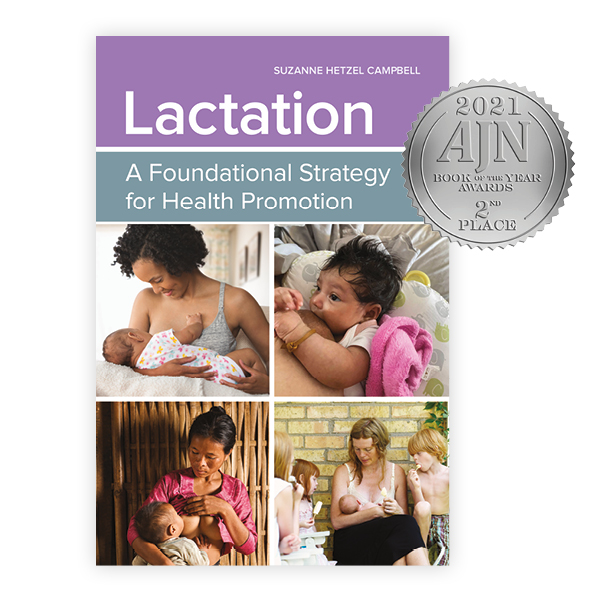Book Overview

Interview with Carole Dobrich of Health e-Learning
Seeking to provide a broad public health approach, the Lactation: A Foundational Strategy for Health Promotion textbook addresses key issues sensitive to major issues in the field of lactation through an interprofessional lens. This foundational text focuses on the socio-cultural grounding required to develop, plan, implement, and evaluate the community-based programs needed by the diversity of breastfeeding families. Encouraging this level of support, protection, and advocacy of the breastfeeding parent are essential for all countries to make progress toward global breastfeeding targets, thereby improving the overall health of the world.
With its international scope and its multidisciplinary approach, this text is a useful teaching tool for anyone who has an interest in a community-based approach to promoting and supporting breastfeeding families.
For more information regarding the text and the author, watch Dr. Suzanne Campbell’s ‘Conversations with Colleagues’ interview with Carole Dobrich of Health e-learning.
Chapter Motivations
Chapter One
Chapter One: Infant Feeding, Industrialization, and History
Chapter One, “Infant Feeding, Industrialization, and History,” examines the sweeping cultural change that prompted mothers to begin the move from breastfeeding and human milk to bottle-feeding and cows’ milk. Many actors played a role in this uncontrolled experiment on human babies—not only mothers, but also physicians, public health officials, public health nurses, dairy farmers, chemists, philanthropists, urban newspapers, and the canned milk and infant-food industries. I find being a historian of medicine especially satisfying because medical history teaches us how our most personal health habits are often shaped by developments in culture and society that are beyond our control, rather than shaped by careful deliberation or voluntary choice. In the case of the changes in infant feeding practices that began in the last quarter of the 19th century, some of the most profound developments in U.S. and world history influenced mothers’ decisions. These factors included urbanization; industrialization; society’s adoption of, and subsequent devotion to, the mechanical clock; the absence of laws regulating food safety; and long-debunked theories formulated by physicians about how girls’ bodies develop. As a historian of medicine, I am especially interested in understanding the complex history behind present-day practices that do not particularly benefit human health. Understanding history helps to instigate positive social and personal change—even in the realm of infant feeding.

Chapter Two

Chapter 2: Key Concepts of Lactation as Health Promotion
Defined as first food, breastfeeding remains the best and most consistent source of nutrition. With a potential to leave the largest impact on maternal and infant mortality, global health and economy, promoting breastfeeding and lactation as a global health promotion strategy is imperent (Global Breastfeeding Collective, 2017). Through this chapter, readers can expect to understand how local, state, provincial, regional, national and global health systems can further promote the initiation and duration of breastfeeding. Highlighting the numerous benefits of lactation and breastfeeding, this chapter provides a holistic background and theme of promoting breastfeeding to those most vulnerable to health disparities in our culture today. Using an interprofessional approach, the chapter presents breastfeeding in the context of Socio-Ecological Framework for Health promotion and provides strategies and additional frameworks in how to integrate lactation support providers into healthcare teams in an equitable manner.
Chapter Three
Chapter 3: Behavioral Theories Examining Lactation as Health Promotion
With a focus on behavioural theories, this chapter aims to enhance the readers’ understanding of how these theories can influence a practitioner’s ability to arrange, implement, and execute goals as healthcare professionals with regards to supporting parents in meeting their infant feeding goals. Through a thorough analysis and comparison of different theories, chapter three explores why further education on lactation is needed and how it should be an integral component of health promotion. By discussing different programs, policies and models of care, Dr. Campbell seeks to show readers the intricate and associated complexities that can affect how an individual makes a health-related decision. The chapter further encourages healthcare providers to utilise an interdisciplinary, social justice and global lens to understand these theories to cultivate a safe and empowering breastfeeding environment catered specifically for different families within all levels in society.

Chapter Four

Chapter Four: Social Policy and Lactation
This chapter outlines the importance of policy on breastfeeding rates and decision-making at the regional level and how it impacts health care systems on a much larger scale. Policy, as defined by the Cambridge Dictionary, is a “set of ideas or a plan of what to do in particular situations that have been agreed to officially by a group of people, a business organization, a government, or a political party” (2019). With these guidelines in place, chapter four seeks to help readers recognize how public policy antecedents can lead to health inequities related to lactation and how it affects a parent’s ability to decide and achieve their breastfeeding goals. As such, health care professionals are encouraged to both understand and engage with the policymaking process in order to help develop and implement appropriate and effective policies to protect the breastfeeding/chestfeeding parents, infants and families affected. This chapter is co-authored by Rhoda Taylor of BC Lactation Consultants Association and Jolynn Dowling, professor of maternal health at Wichita State University and author of chapter two in this foundational textbook.
Chapter Five
Chapter Five: Relational Practice and Lactation
Exploring the Relational Framework for Breastfeeding Support, co-authors Tina Revai and Stephanie George explore how breastfeeding heavily contributes to the parent’s emergent identity. This chapter explores and highlights how a relational framework can guide practice in a manner that foregrounds how experience, context, history and meaning are mediated as it potentiates the ability to resist and disrupt systemic inequities. Discussing the integral topic of how health is uniquely experienced by each individual, the chapter highlights how a relational approach is the foundation to the provider-parent interaction and explores the important topic of how health care professionals must differentiate between cultural humility and implicit bias as it affects interactions with parents. Thus, the chapter explores and encourages readers to practise trauma-informed care and reflective practice to ensure that the breastfeeding individual considers the problem solving as a communal and collaborative effort. Co-authored by Indigenous midwife and part-time instructor at McMaster, Stephanie George and a sessional instructor at North Island College, Tina Revai; chapter five is an essential read for all healthcare providers.


Stephanie George (pictured left) & Tina Revai, (pictured right)
Chapter Six

Chapter 6: Baby-friendly Initiatives, and History
With the intention of examining lactation in the global context of health promotion in practice, chapter six thoroughly explores and analyzes how lactation proves integral to public health. Discussing the role and responsibilities of health care professionals in supporting families with their infant feeding goals, Dr. Campbell demonstrates the intertwined relationship between global policies and initiatives to decisions for care at the regional level. Introducing policies such as the Innocenti Declaration and the Baby-Friendly Hospital Initiative, these key practices are defined and described to help readers better understand how these international initiatives have yet to be fully realized. Highlighting the specific exhaustion of resources, government support and general fatigue of policy makers and providers, this chapter encourages providers to continue and to not be dissuaded given the health, economic and global benefits of supporting parents.
Chapter Seven
Chapter 7: Developmental Processes of Lactation as Health Promotion
The journey of a fetus’ development, birth and first moments are all heavily intertwined with the mother’s breastfeeding success as well as decisions. From when a woman is pregnant to the birth practices they experience, all events can potentiate or thwart the parent’s confidence and adaptive behaviours as she transitions into the role of a parent. Defining postpartum interactions, chapter seven as authored by Dr. Miller explores how even first moments between parent and infant can affect how a parent bonds with, feeds and nurtures their infant. Thus, health professionals are called to optimize health outcomes for birthing parents and newborns by encouraging and integrating breastfeeding friendly practices and policies to help partner with and support parents who are breastfeeding. Overall, the chapter hopes to educate readers on early caregiver practices, behaviours for health promotion of breastfeeding and infant behaviours that will influence breastfeeding.

Chapter Eight

Chapter 8: Globalization and Lactation as Health Promotion: Brazil
Chapter eight defines the concept of globalization within the context of lactation and maternal–child health promotion. It also reflects how globalization may affect people’s health and health promotion per se, related to improving and supporting breastfeeding in a globalized and contemporary society. From another perspective, chapter eight describes an international point of view on lactation and infant feeding; analyzing a multi-professional and interdisciplinary international experience regarding breastfeeding in an industrialized country. Through this chapter, Nicole focuses on how interprofessional teams can act to support new parents in their infant feeding decisions and defines which individuals in a mother’s support system should be involved in providing input on breastfeeding decisions. Combined with Dr. Campbell, co-author of chapter eight, and her experiences within North America, Nicole’s expertise and experiences from Brazil in supporting a broad, political health system is contrasted against the global health promotion strategies adopted by Canada and the United States.
Chapter Nine
Chapter Nine: International Perspectives: Best Practices for Supporting Breastfeeding Across the Continuum
We live in a global world and the Global Breastfeeding Collective (WHO, 2017) identified that ‘countries are not adequately protecting, promoting, and supporting breastfeeding through funding or policies. As a result, a majority of children in the world are not breastfed as recommended’ (p.1).
This chapter examines best practices to support breastfeeding globally, including BFHI and Neo-BFHI; international initiatives such as the World Alliance for Breastfeeding Actions (WABA); and examples of examining breastfeeding as health promotion within the health impact pyramid and a public health model to scale up lactation promotion and support. Students/practitioners/stakeholders are walked through the AIDED Framework (Perez-Escamilla, et al., 2012) and given activities and probing questions to consider for application to their context.
Connecting how supporting parents in their infant feeding journeys can affect meeting Sustainable Development Goals (SDGs) for 2030 (United Nations [UN], 2020) helps to identify concrete connections between public health initiatives and health promotion targets for global health. A case study shares a 20-year perspective scaling up breastfeeding support in a state and how that work set some models for BFHI and peer counsellor programs across the US.

Chapter Ten

Chapter Ten: Equitable Lactation Health Promotion
Focusing on advocating for health inequities within lactation, chapter 10 brings light to the health disparities between breastfeeding initiation and duration rates in different races and classes. Using this chapter, Dr. Campbell aims to provide tools for learning and unlearning while urging readers to reflect on themselves to observe and recognize any implicit biases they may have. Recognizing that she, herself, is a white, privileged and educated female; she understands that her attempt at capturing the full extent of patient voices suffering from racism will not be complete and is a challenge. But, through this text, she hopes to serve as an ally and partner and provide a conceptual framework bringing light to health promotion and breastfeeding with relation to equity and social determinants of health. Chapter 10 will also outline any barriers and strategies to support parents on their infant-feeding goals and introduce methods in which interdisciplinary teams may help.
First Nations Health Authority Key Links
Chapter Eleven
Chapter Eleven: Breastfeeding: An Essential Link in Healthy Weight Promotion and Obesity Prevention
Cecilia Jevitt provides an oversight on the effects of socioeconomic disparities and environmental disadvantages on the chronic disease of obesity. Through an exploration of new terms and physiological concepts regarding obesity; the chapter describes how different aspects of daily living affect the risk factor of obtaining obesity as well as strategies in reducing these effects. It also describes why the mechanical aspects of obesity can impact the breastfeeding dyad and the risks it poses for the infant’s health. However, the chapter also outlines the improvements initial breastfeeding can cause in decreasing future risk while highlighting strategies of promoting healthy weights.

Chapter Twelve

Chapter Twelve: Infant Feeding in Emergencies: Where the Safety Net Falls Away
This chapter discusses breastfeeding amidst an emergency and strategies for health promotion during such uncertain times. Relating to certain aspects that are prevalent in our current daily lives, Michelle Branco communicates the importance of breastfeeding to provide infants with food security and prevent malnutrition or chronic illnesses. Throughout the chapter, she artfully discusses promotion strategies that mothers and health care professionals can follow to protect existing breastfeeding procedurals and to support the initiation of such practices. Taking into account the different and hectic environment, the chapter also encourages readers to think about and consider interventions to help reduce infant and mother mortality as they are the most at risk population during these times. Thus, chapter twelve unpacks why and how breastfeeding makes these populations more resilient during the recovery period.
Chapter Thirteen
Chapter Thirteen: Breastfeeding for People Experiencing Criminalization and Incarceration
Women are the fastest growing population in prisons around the world. The rising incarceration of women affects reproductive health including the right to breastfeed, breastfeeding intentions, success and experiences for lactating people and children. Breastfeeding is under-researched among people experiencing incarceration. This chapter reviews what we do know about breastfeeding among people experiencing incarceration and describes the particular benefits of and barriers to breastfeeding for this population. The chapter explores legal protections that are supportive of breastfeeding for people experiencing incarceration and summarizes important legal cases which dealt with the right to breastfeed. The chapter concludes with recommendations for best practices.

Chapter Fourteen

Chapter Fourteen: Domperidone to Treat Low Milk Supply: Drivers of Use, Efficacy and Safety
Chapter Fourteen delves deeper into the safety and efficacy of using the drug domperidone to treat low milk supply. Serving as medication to treat nausea, vomiting and indigestion, the drug domperidone has rapidly morphed into one that the non-medical community sees as a pill that can drastically and almost magically improve breastmilk supply. However, the administration and prescription of this drug have not been properly approved by Canadian jurisdictions, yet there is still an increasing number of mothers who routinely acquire this drug through off-label prescriptions. There has been no significant or conclusive evidence outlining the efficacy and success of domperidone’s effect on increasing milk supply. However, scientific literature and research have already proven a link between domperidone usage and the potential side-effects that accompany this. Thus, this chapter fully explores the detrimental harms that the drug may bring and the potentially fatal consequences.